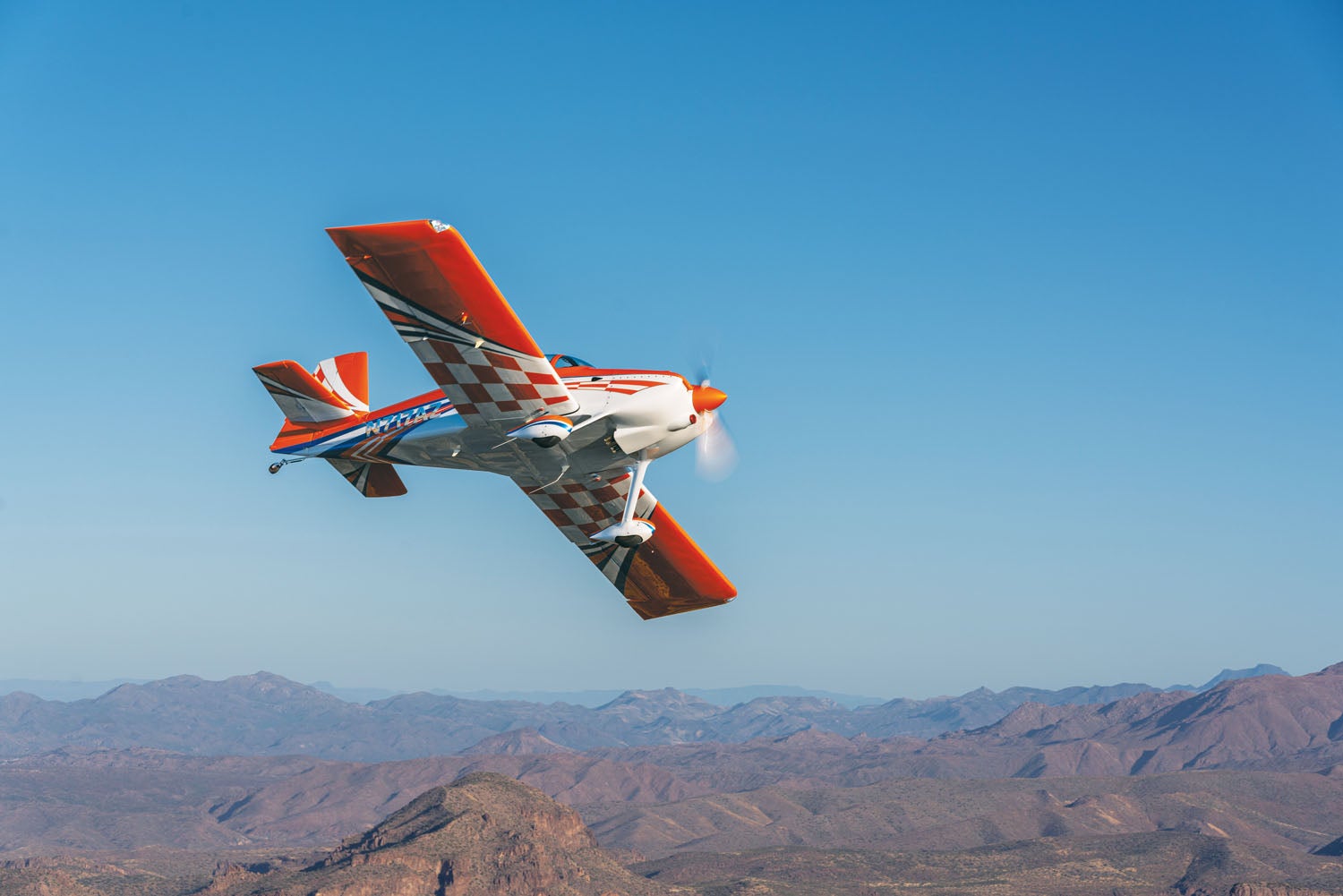 Aircraft builders, amateurs like you and me who create for the fun and challenge of it, often have the same seemingly simple goal in mind: finish the airplane. With the airworthiness certificate becoming the most important piece of paper, accolades and awards become secondary. For the vast majority of us, this is as good as it gets and, frankly, as it needs to be.
Aircraft builders, amateurs like you and me who create for the fun and challenge of it, often have the same seemingly simple goal in mind: finish the airplane. With the airworthiness certificate becoming the most important piece of paper, accolades and awards become secondary. For the vast majority of us, this is as good as it gets and, frankly, as it needs to be.
A relative few very ambitious builders, often on their subsequent builds, set higher goals still—and a handful go for it all. The holy grail for aeronautical accolades is an award delivered each year at AirVenture, where the crème de la crème vie for arguably the highest possible award in the industry, the Grand Champion Gold Lindy.
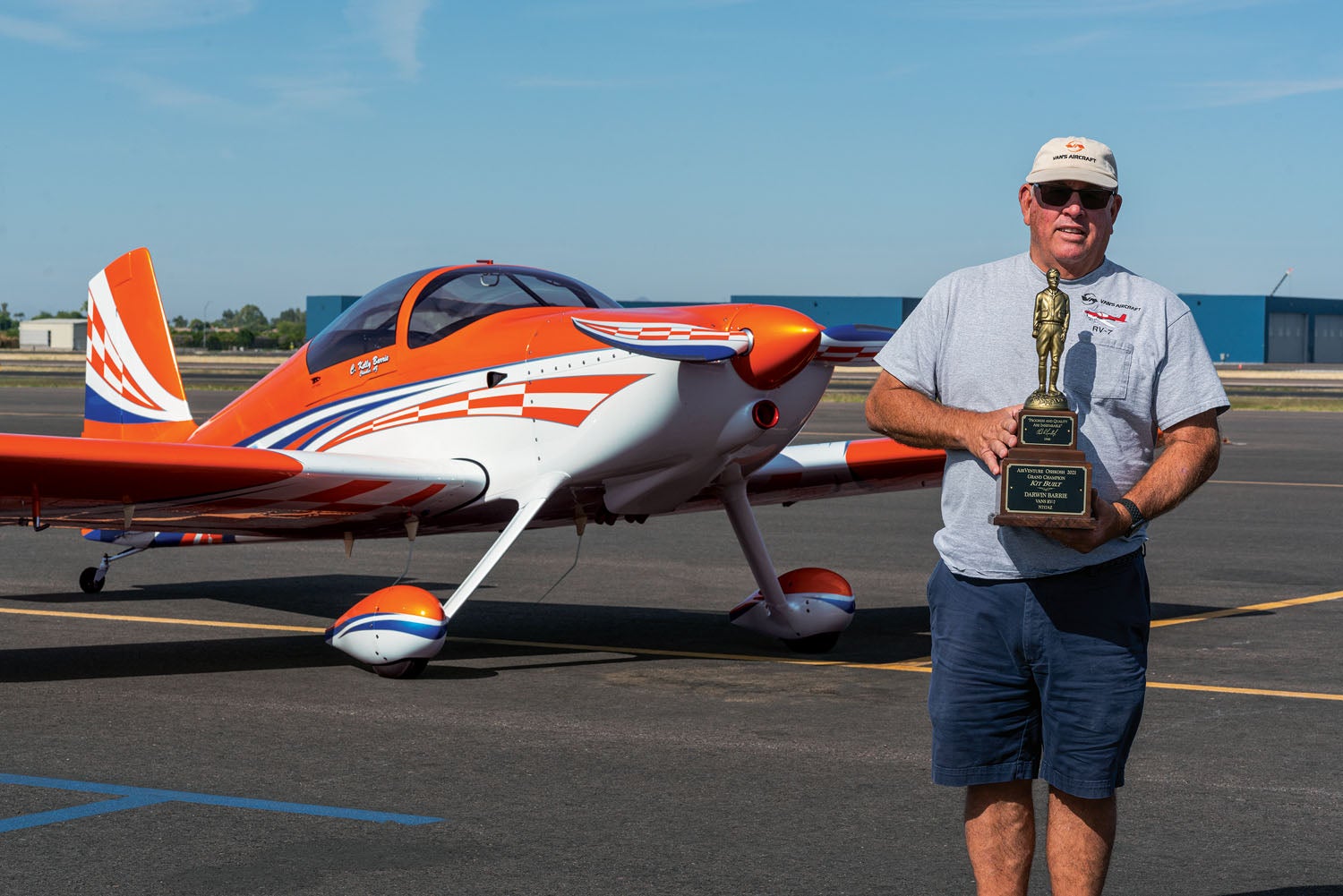
Darwin’s Theory of Gold
To get a better sense of what it takes to earn a “major award,” I spent time with Darwin Barrie of Chandler, Arizona. His Van’s RV-7 won the 2021 Grand Champion Kitbuilt—Gold Lindy at the most recent AirVenture. Because it’s hard to fully appreciate the effort and thought inherent in composing a Gold Lindy winner as you walk by any competitive entrant at AirVenture—and, for that matter, you don’t even know it’s a winner, yet—let’s take a few pages to show what has gone into this particular example of an award winner.
Darwin vows that, unlike some others, he didn’t start out specifically with the goal to win a trophy. He just wanted to build a good-looking, high-performing, mechanically safe and reliable traveling machine. However, as time went on and the project neared completion, his helpers and supporters really started trying to convince him that he had something very special on his hands and encouraging him to enter the mother lode of static aircraft competitions.
Darwin’s passion for aviation began as a child building and flying model airplanes. He continues that avocation in competitive R/C modeling as a sponsored member of Team Futaba, which is one of the premier manufacturers of hobby and industrial radio control equipment in the world and one of the most sought-after sponsors for competitive professionals.
When his dream of becoming a military fighter pilot followed by a traditional airline career hit the headwinds of unfortunate timing related to the aftermath of the Vietnam war, Darwin instead pursued a career in law enforcement. There, he was later directly involved in the development and operation of public services aviation programs, especially involving helicopters. After retiring from 30 years of service in both police and sheriff departments, Darwin started flying helicopters for Emergency Medical Service operations in the Phoenix area. He retired from commercial flying in 2020 and now accepts freelance work ferrying helicopters for various entities. For the last decade, Darwin has also volunteered to join the elite team that flies the Bell 47 helicopter tours at AirVenture.
In 2005, Darwin completed his first kitbuilt aircraft project, an RV-7, which won awards in its own right. Not long after, Darwin came upon an RV-7 kit project that had barely been touched that was just too good of a deal to pass up. Taking what he learned, positively and negatively, from his first project, he started work on his eventual Grand Champion. He owned the project for about 10 years before first flying but said that the bulk of the project was built over a four-year period.
Timing Is Everything
In what Darwin describes as a “twist of fate,” he was approached by Barrett Precision Engines, who knew of his project and inquired if he might be interested in a brand-new Lycoming IO-390 engine. This offer turned out to be exactly what Darwin had been looking for: a brand new engine yet assembled with all of the special BPE treatments like matching and balancing the rods, balancing the crankshaft to tighter-than-factory tolerances and other upgrades like Barrett’s unique valve-seat treatment.
Normally, the angle-valve Lycoming makes the RV-7 a little nose heavy, but a Whirl Wind 74-inch composite-blade propeller helps reduce overall weight and keep the CG where it needs to be. Of course, the 390’s 210 hp (known from the Barrett-supplied dyno readings) offers up strong takeoff and climb performance. The RV-7 is already a spirited performer, but more power makes it sparkle all the more so, and the 390 is known to be a fairly fuel-efficient engine, so the penalty in fuel burn isn’t all that great.
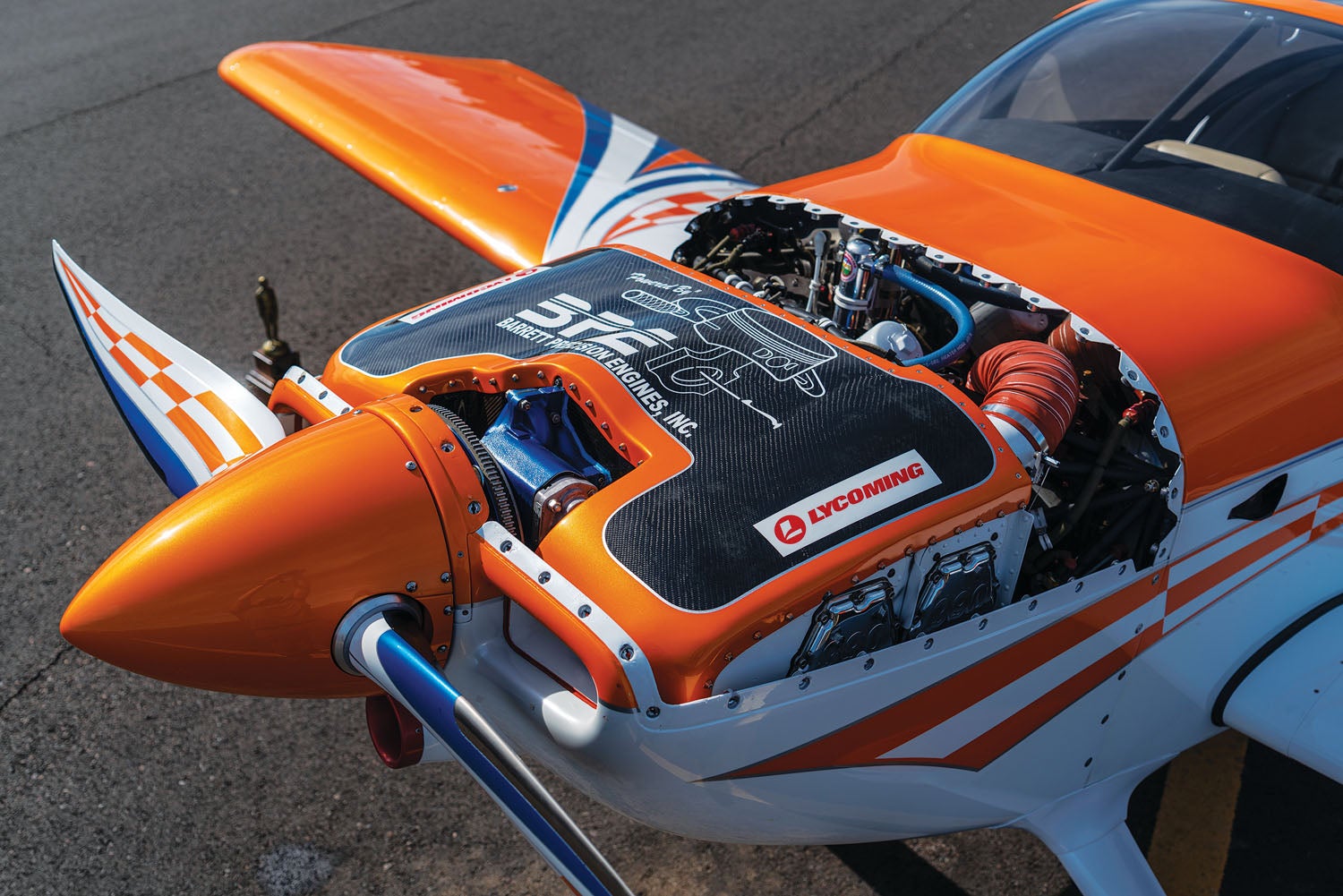
More FWF Details
The Barrett IO-390 breathes through a Precision Silver Hawk fuel injection system and a Vetterman four-pipe tuned system. The ignition system is comprised of Slick magnetos modified with G3i electronic components for a true “best of both worlds” layered system—the system can run on external power with variable ignition timing but can also revert to self-powered magneto operation if need be. Power for the G3i system, as well as the rest of the airplane, is handled by a Vertical Power integrated system.
Powerful engines make heat, so Barrie’s RV-7 has an oil cooler sized for an RV-10’s six-cylinder Lycoming, fed by a 4-inch duct; the airplane also has an AntiSplatAero air-oil separator. The power package is attractively capped with a custom hand-crafted plenum featuring the aircraft’s paint scheme and inlaid logos of Lycoming and Barrett Precision Engines, making the whole presentation a delight to the general public and enthusiasts alike. There are several custom cowl modifications to air intakes, forward baffling, and the aforementioned plenum that are all custom hand-crafted from composite material and/or carbon fiber. If any airplane can actually be more attractive with the top cowling removed, this one sure is.
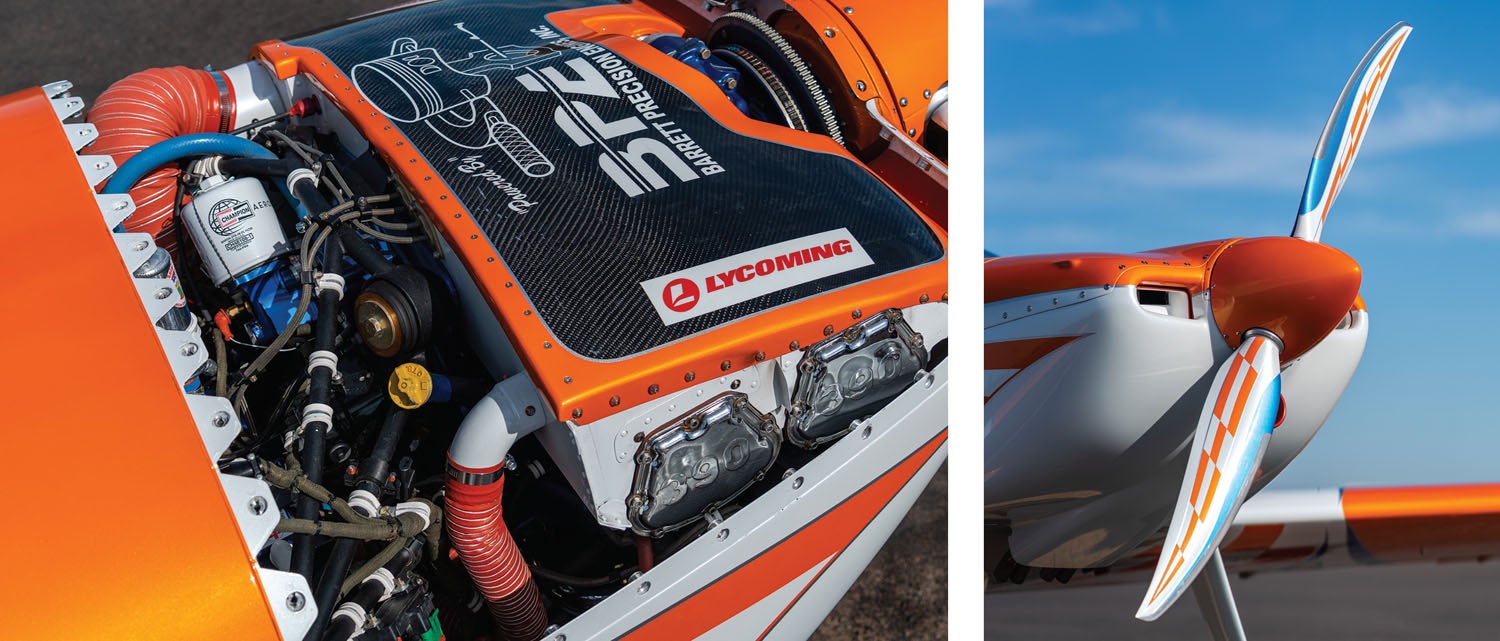
Barrie strove for more than just good looks on his RV-7. “As a self-proclaimed safety nut, I wanted to make N717AZ an example of safety,” he says. “It was built with every possible safety feature in mind.” Some of his approach has to do with philosophy, but it’s all amazingly well-executed. “Starting with the FWF, all wiring is sheathed in high-temperature Nomex covering. I discovered this product was used in the medical helicopter that I fly. All wiring in the helicopter is covered with Nomex split sheathing. I tracked a source and used several sizes to accomplish the goal. The sheathing is good up to 400° F and is flame resistant,” Barrie says. Securing components FWF gets the same treatment. “All Adel clamps are high-temperature versions. I even replaced the Lycoming Adel clamps used to hold injection lines in place with high-temperature versions.” Yes, the standard factory clamps that hold the fuel-injection spider lines are the “wrong” kind.
Barrie continues: “Although used sparingly, all zip ties used FWF are high-temperature variants. There are no zip ties connected to the engine mount!” Darwin gets high marks from us on this count. “All fuel lines are certified stainless steel fittings with fireproof covering molded to the lines. Each made to exact specs for the purpose,” he says. “Pass-throughs for the oil cooler baffle control and auxiliary air control cable are special hard-anodized, high-density aluminum. The cable transition is coated with a high-temperature silicone compound, while the electrical pass-through connector is a Lancair product. It is high-temperature fill-molded constructed. Other pass-throughs not as visible are made from high-density phenolic components. Anodized standoffs were made for the brake lines. This keeps the lines from any possible contact with the firewall and a possible abrasion source.” You don’t have to look far to realize that Darwin built his RV-7 with great care and foresight; the list of what he’s done simply confirms it.
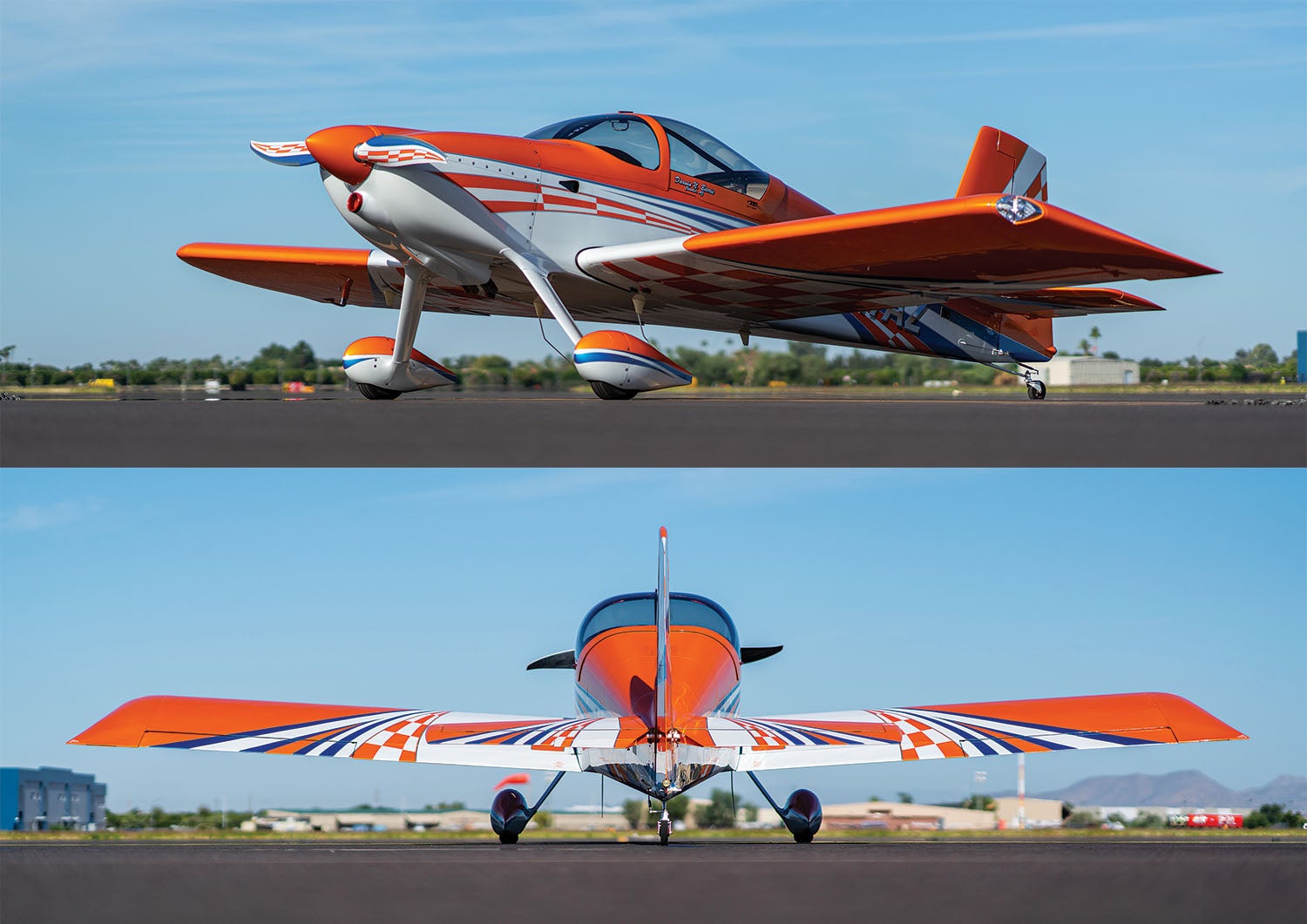
Let’s Go Inside
Darwin’s custom instrument panel is arranged in today’s popular three-screen layout with a Garmin GTN 750 in the center and an Advanced Flight Systems 5500 EFIS in front of each seat. The displays are fed and supported by a Garmin remote-mounted audio panel, 330ES remote-mounted Mode S transponder and SL 40 com radio. Contributions by Advanced and Dynon include dual independent OAT sensors, GPS and ADS-B In. The TruTrak 880 autopilot does the flying and has its own artificial horizon as a backup to the AFS screens.
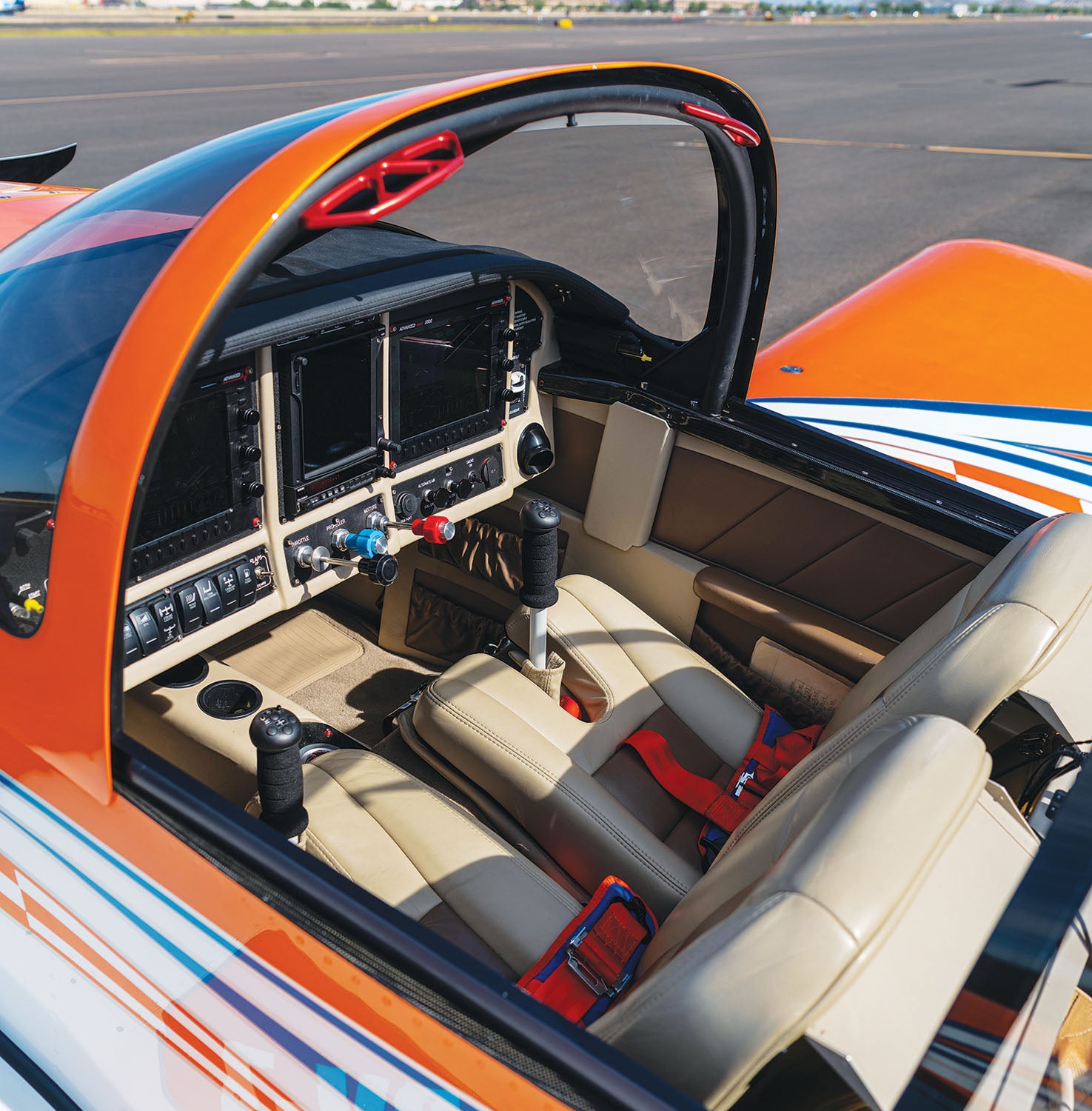
The system is all interconnected by an Approach Fast Track wiring hub and cables, and power is primarily supplied and monitored by a Vertical Power VP-X electrical-system hub. Additional features of the instrument panel include dual TCW backup batteries for the primary EFIS displays, as well as an XM weather and radio module and a Guardian 455 multifunction pulse oximeter.
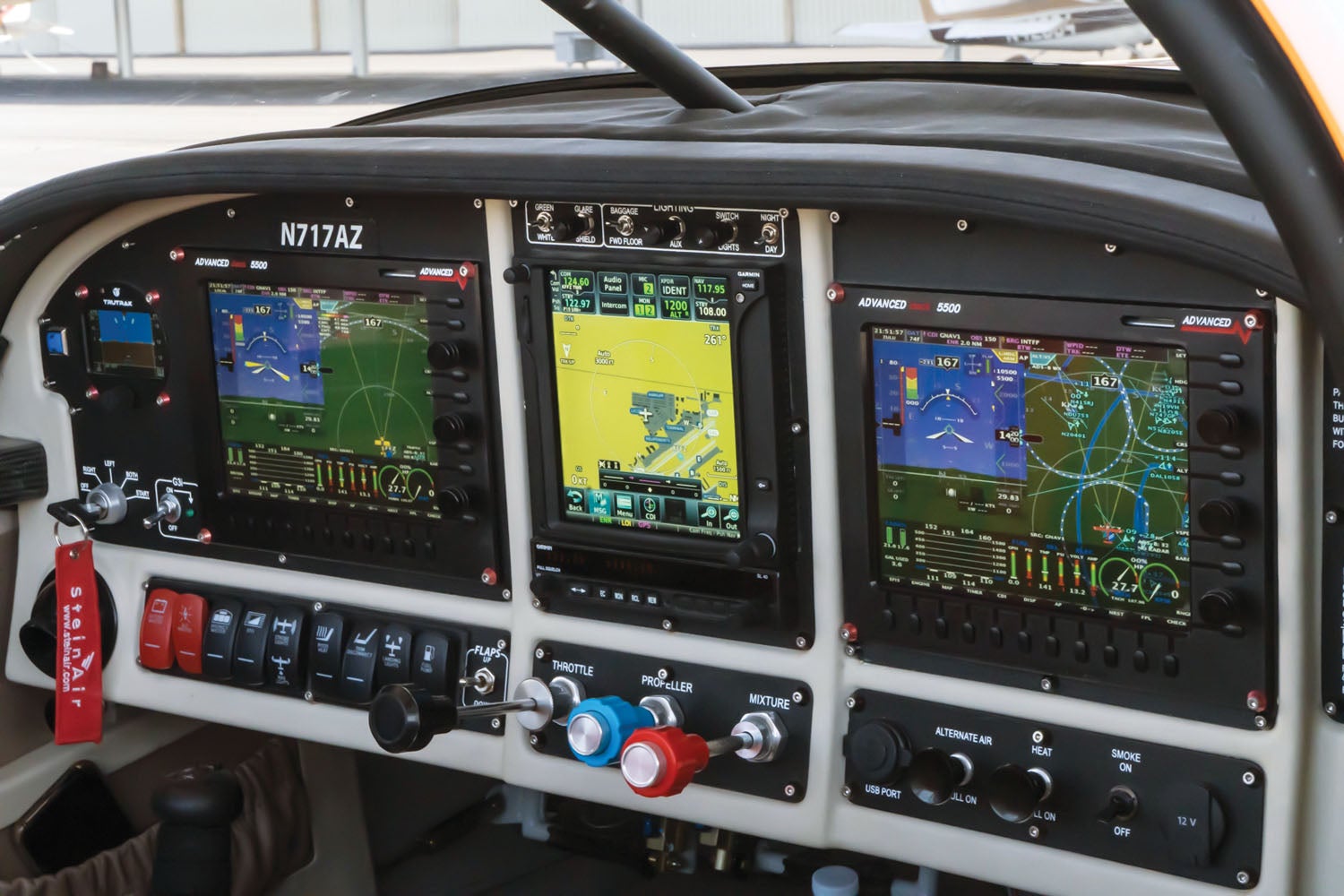
Lights On
“Since I do fly at night quite often in my work commute,” Darwin says, “I decided to make the cabin as ‘night friendly’ as possible. This required stripping the glossy gray from the roll bar, cross brace and canopy frame. The pieces were then powder coated in a high-temperature flat-black finish. The interior paint is satin to prevent glare.” That’s dedication to a cause.
Outside, Darwin’s RV-7 has wing-tip recognition lights on the trailing edge, LEDs, of course. “I’ve found from my former job as a medical helicopter pilot that other aircraft are usually first observed by lighting, even during the day. This is especially important with the small size of RV aircraft. The decision to install trailing edge lighting proved accurate. A fellow pilot flying in trail said the lights are extremely bright, making the plane very easy to see in daylight conditions,” he says.
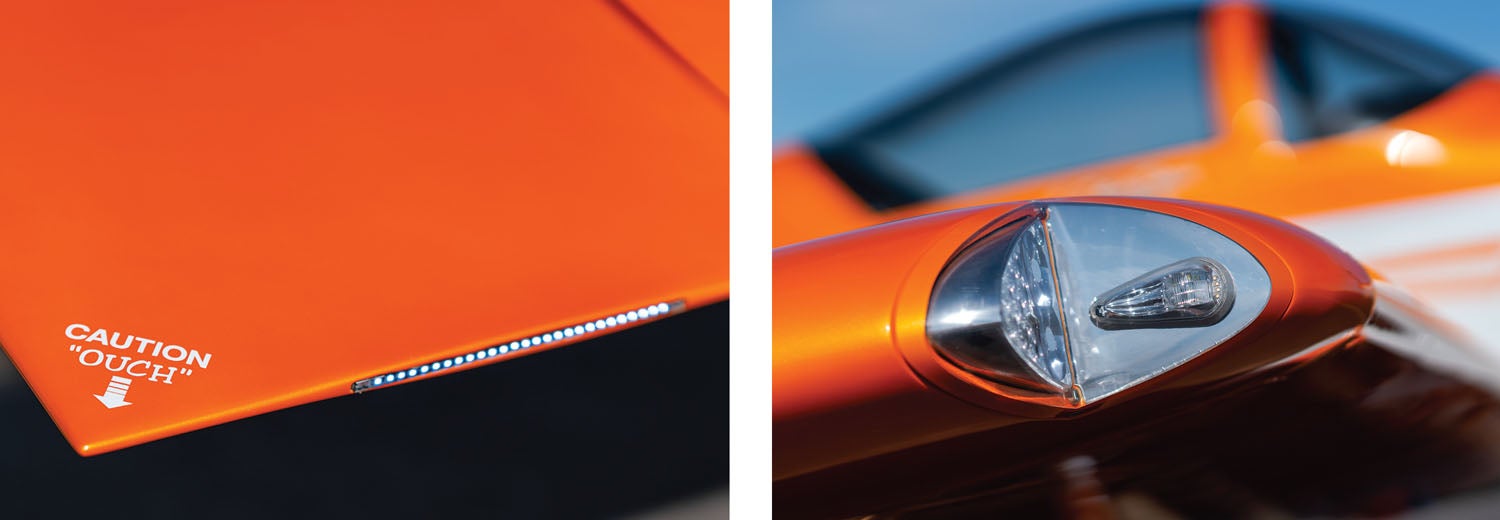
More About the Build
Darwin stresses that he is a big fan of a “buddy system” arrangement that really helps to keep a builder focused and motivated. He credits his great friend Ron Moring, who, despite living across the country, would come out for days or weeks at a time to help build, design and actually machine many of the custom pieces and features of the airplane.
Asked if there were systems or components that he initially desired but had to abandon for whatever reason, Darwin says that he initially wanted a fire-suppression system, but that got pushed aside into the “to be continued” category. Darwin also pre-wired the airplane for a smoke system, but that became less important to him over time—it easily could be added if it becomes desirable at some point. He also mentioned that he completely changed his avionics choices and layout twice during the build and eventually came to the realization that it was going to be impossible to keep up with all the new advancements and to just “hit the stop button and get it done.”
Having the project close by also helped. Darwin also stressed that living on a residential airpark, where his hangar and shop were literally a kitchen door away, really made a project of this magnitude more convenient. One of Darwin’s favorite adages is “work smarter, not harder.”
What would he do differently? “Don’t get in a hurry to get the project onto its landing gear, and in the same vein, don’t be in a hurry to get the engine installed.” Delaying both of these big milestones would allow easier access to other building tasks that get more complicated when the project is on its gear and engine installed. He also said he would select paint colors that didn’t turn out to be some of the most expensive on the market.
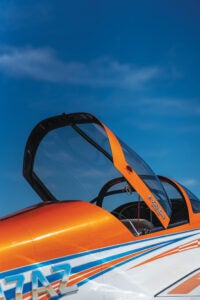 Projects of this magnitude and quality are rarely accomplished without significant help and support. (Though cubic money isn’t quite what you think it would be. Darwin says he has about $150,000 in the project.) In addition to the previously mentioned companies and individuals, there is one more to be mentioned. Like most successful builders, Darwin cherished the loving support of his dear wife, Kelly, who participated and assisted throughout the project. Kelly is an accomplished pilot, and is as equally proud of the Grand Champion result as is Darwin. Her name is as prominently featured on the canopy skirt as is Darwin’s on the opposite side. Darwin says that without the efforts of many, especially Ron and Kelly, the project would still be a project and not the current reigning Grand Champion Gold Lindy. Well done, Barries!
Projects of this magnitude and quality are rarely accomplished without significant help and support. (Though cubic money isn’t quite what you think it would be. Darwin says he has about $150,000 in the project.) In addition to the previously mentioned companies and individuals, there is one more to be mentioned. Like most successful builders, Darwin cherished the loving support of his dear wife, Kelly, who participated and assisted throughout the project. Kelly is an accomplished pilot, and is as equally proud of the Grand Champion result as is Darwin. Her name is as prominently featured on the canopy skirt as is Darwin’s on the opposite side. Darwin says that without the efforts of many, especially Ron and Kelly, the project would still be a project and not the current reigning Grand Champion Gold Lindy. Well done, Barries!
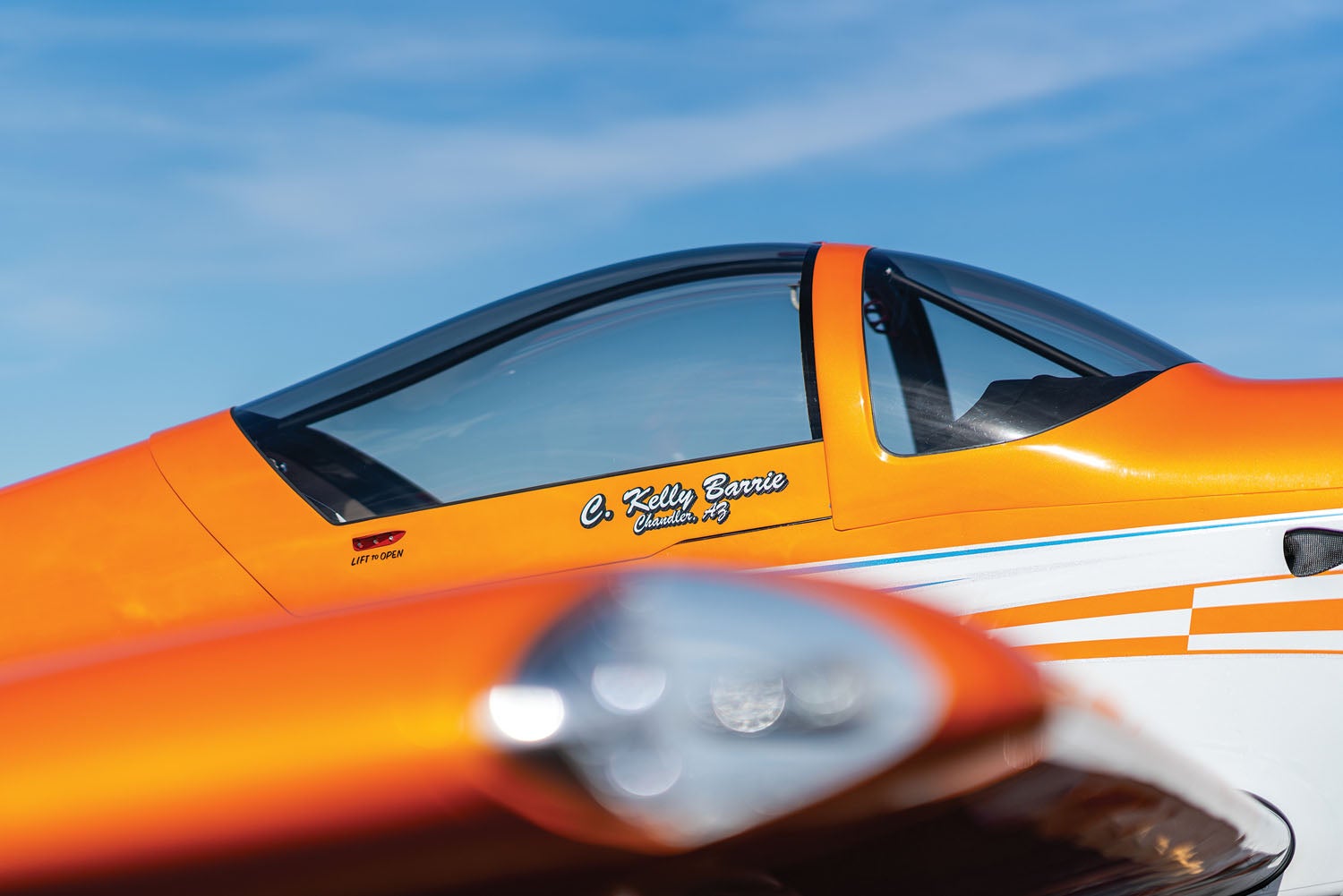
Photos: Jon Bliss, Kenny Tydeck



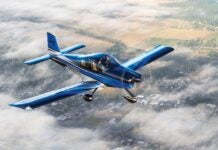










Truly impressive wingspan — 254 ft…
It’s the biggest RV-7 ever! 😉 We’ve corrected the error.
Can you provide the source of the custom LED position lights that adorn the training edge of the wingtips? I’m interested in a similar installation on my Lancair 320. Thanks!